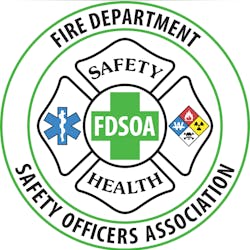SCOTTSDALE, Ariz. – It may be hard to believe, but thermal imaging cameras have been in the fire service for 20 years and they have become essential tools for firefighters.
It has become not a question of whether departments should have one, it’s more about having multiple units, perhaps as many as six, even on a bread and butter single family structure fire.
That’s what Mike Richardson, division chief of Training & Safety for the East Louisville Metro Fire Protection District in Kentucky, said to a group of firefighters at the Fire Department Safety Officers Association's Safety Symposium.
“Thermal imaging cameras have pros and cons and we’ve got to know both to keep safe,” Richardson said.
Richardson said thermal imaging cameras or TICs are just like any new piece of equipment, you have to train on it and you have to use it to be effective.
“Hopefully, your camera isn’t in the chief’s vehicle because that’s where they were when they first came out,” Richardson said. “They were expensive and nobody wanted it to get broken."
Tallying up the number Richardson said he thought were needed on a straight up house fire, he listed off one for the safety officer, one for the rapid intervention crew, one for each interior crew, and one for the incident commander.
While most departments, particularly small rural ones, can’t afford that many cameras, Richardson said there is no reason to own them.
“What do you do when you need more apparatus?” Richardson asked. “You call mutual aid.”
There is, however, a risk of not having enough cameras on the scene immediately because of response times from mutual aid companies. Larger metropolitan areas should consider having multiple thermal imaging cameras in the cabs of apparatus ready to go in case of fire in large warehouse and similar buildings.
“I don’t think you can ever have enough on the scene,” Richardson said.
Richardson also cautioned the audience about heavy reliance on the thermal imaging cameras. Too often, firefighters will simply stand up and walk around with a camera because they can now see.
“What happens when you stand up in a fire,” Richardson asked. “That gets you up into the thermal layer. You have got to stay low, just like always. ...They should never replace the basics. If I can’t see my hand in front of my face, I probably shouldn’t stand up and walk around in the fire.”
Richardson said that he’s seen firefighters in training sessions lose their reference points because they can see the door and they will follow the shortest line to the egress.
“What’s the problem with that,” Richardson said. “Nothing until the camera fails.” He added that firefighters should be taught to use the walls as their reference points and certainly the hose.
“There is some debate about not letting rookies train with TICs at all,” Richardson said, adding that he has some reservations as well, but believes the technology is here to stay and they need the training.
Training is key to effective and safe use of cameras, he said, adding that TICs have been listed as a significant contributing factor in line-of-duty deaths and have gotten firefighters in trouble as well because they don’t understand the information the device is providing.
For example, Richardson said TICs measure the temperature of surfaces, not the air or the flames themselves. A reading on a ceiling might be less than 400 degrees, but the air traveling near it might be 800 degrees or more and, indeed, might be approaching flashover stage.
Richardson said training is needed when new cameras are put in service, especially if they are different brands.
“There is no consistency,” Richardson said, stating that some on/off buttons are red, others are green and still others are different colors completely.
“You have to train to know the differences,” he said.
And, depending on the model, Richardson said cameras can come in two or three stages of sensitivity and can also have color screens.
At high sensitivity, objects are clear to see, at medium, they’re less likely to be seen. And in low sensitivity, they’ll be virtually impossible to see. Each level reduction is a function of increasing temperature, Richardson said.
Firefighters have come to expect that white images on the TIC screen are hot and the black are cold, but that can sometimes be reversed, sometimes by the owner’s discretion and other time because of “reverse polarity” which will likely need service to correct.
Cameras can do more than just be effective at structure fires. He said that fire departments should consider using them on technical rescues, or hazardous materials calls.
They can also be used on the outside of buildings to help determine where the fire is, the structural integrity of floors and even what kind of fire might be burning inside.
Richardson acknowledged the pros and cons of the cameras, but is a huge proponent of them, as long as there’s adequate training.
“Sometimes, we have to get our heads of the camera and into the real world,” Richardson said. “Just because the thermal imager tells you something, don’t just buy it hook line and sinker. Get some other verification.
More from FDSOA:
- FDSOA's Apparatus Symposium Opens in Ariz.
- FDSOA Symposium: Diesel Emissions Standards Need not be so Scary
- FDSOA Symposium: NFPA 2015 Apparatus Standards Reviewed
- FDSOA Symposium: Politics Play a Role in Apparatus Purchasing
- FDSOA Symposium: Experts Field Apparatus Questions
- FDSOA Symposium: Detroit FD Weathers City's Bankruptcy
- FDSOA Symposium: Apparatus Design Is Important for ISO Ratings
- FDSOA Symposium: Drones Can Be Valuable Tools For Responders
- FDSOA Symposium: NFPA Focused on Alternative Fuel Emergency Safety
- FDSOA Symposium: Graham Lectures on True Risk Managment
- FDSOA Symposium: Pros and Cons of Thermal Imagers Discussed
- FDSOA Symposium: Maintenance is Key to Keeping Apparatus on the Road






